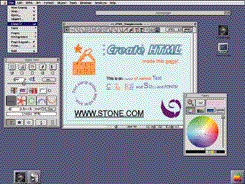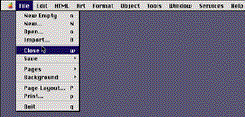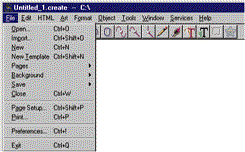

|
Volume Number: 13 (1997)
Issue Number: 7
Column Tag: Rhapsody
Porting to Rhapsody PPC from OPENSTEP
by Andrew Stone, Chief Executive Haquer, Stone Design Corp.
Want your OPENSTEP application to run on more than one platform? Apple is making it easy
In late 1995, when the future for NeXT Software, Inc. seemed rather bleak, the first beta version of OPENSTEP 4.0 shipped to a few faithful developers. Faced with doing Java development in incomplete environments, I decided to yet again recommit to OPENSTEP and port our best selling drawing and design program, Create, which contains the Stone Libraries upon which our other apps are based. In an effort to save others from the pitfalls I fell into, I produced a porting guide http://www.stone.com/porting/ documenting the likely gotchas of the process of porting from NEXTSTEP to OPENSTEP.
It took me one month to port this 100,000 line code base to a state of linking and limping. After 8 months of intense debugging and working back and forth between the NT and MACH teams at NeXT and the SOLARIS OPENSTEP team at SUN Microsystems, Create 4.0 rolled into beta, and was the first app to ship for OPENSTEP in the fall of 1996. Proving the claim of true cross platform compatibility, it ran on Windows 95 and Window NT, SOLARIS, and OPENSTEP MACH for Motorola, Intel and SPARC architectures. Since the development and porting tools were just being debugged for the first time and my OPENSTEP knowledge was still nascent, the process was lengthier than a port from NEXTSTEP to OPENSTEP would be today. We shipped, and were underwhelmed by the lack of response from a beleaguered set of OPENSTEP users.
Apple acquiring NeXT on December 20th, 1996 changed all of that, proving once again that reality is far stranger than fiction. The Wheel turned full circle and the renegade ex-Mac developers were back home!
'Tis true that perseverance furthers, because 2 weeks prior to the 1997 WWDC on Cinco de Mayo, I was invited to NeXT Software's headquarters in Redwood City to build Create for the PowerPC. Unlike any previous visit to NeXT where I was watched with hawk-eye and not allowed to go anywhere unescorted, I was given full reign of the second floor of engineering, replete with my own office and access to that legendary espresso maker.
Two binaries were needed for the show: one for Rhapsody running on Intel, the other for Rhapsody running on PowerPC. The app was also built to showcase Yellow Box running on Windows with the Windows look and feel. This build compiled without warning, the app launched and hung. It turns out that I had a vestigial line of code from NEXTSTEP 1.0 circa 1989:
[menu display];
This was a workaround to get the menu to redraw after dynamically adding menu items. However, in the brave new world of Rhapsody, one cannot be sure what a menu is. Normally a menu is a subclass of NSView, which contains a display method. Under Rhapsody, Apple's drop-down menu is not a subclass of NSView, and does not recognize the display method.
The engineers at Apple/NeXT, in the midst of going through a total reorganization, had ported the kernel and compiler tools to PPC within a matter of months. They had built a cross-compiler to build PPC binaries from Intel machines, and once again, Create compiled cleanly. The PPC kernel was only a few days old, still dripping with amniotic fluid, when the first commercial app just came up and ran. As key team member Matt Watson is oft heard saying, "It just works!" Shouts of joy from the team could be heard throughout the building.

True to the promise of Rhapsody, no coding changes were required for the PPC/Yellow Box port, a few NeXT Interface Builder files (nibs) had to be adjusted to be more Mac-like -- mainly Create's main menu had to have its menu items reordered and renamed slightly to feel like a Mac. To solve this problem, a new interface loading paradigm was introduced: if a nib file has a platform suffix, that nib file is loaded instead of the one without a suffix:

NEXTSTEP look as provided by _NEXTSTEP___<NIB_FILE_NAME>-nextstep.nib

Macintosh look as provided by _Macintosh:__<NIB_FILE_NAME>-macintosh.nib

Windows look as provided by _Windows NT/95_<NIB_FILE_NAME>-windows.nib
The Mac and Windows NT/95 menus use a separation marker that you can find on the Menu palette of IB when you set the "Interface Style" in Interface Builder's Preferences (General) to "OPENSTEP for Windows." The separation marker must be disabled in the IB inspector to give it the light gray look. Menu organization and menu item naming should follow the User Interface guidelines of the target platform.
Having taken the time to learn Java and the various development environments from Sun and Symantec over the last couple of years, I can unreservedly say that Rhapsody rocks the house and Java has a lot to implement before it offers the power, elegance and integration of Rhapsody. After this delightful porting experience, I believe that Rhapsody is Write Once -- Runs Right Everywhere.
Andrew Stone, an early HyperTalk developer and co-author of "Tricks of the HyperTalk Masters" emigrated to the NeXT community in 1989, going on to write such NeXT classics as TextArt, Create, DataPhile and 3Dreality.



- SPREAD THE WORD:

- Slashdot

- Digg

- Del.icio.us


- Newsvine


